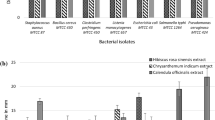Abstract
A system is described for identifying grain-inhabiting nephrotoxicPenicillium spp. based on their colony characters on Czapek yeast extract agar, yeast extract sucrose agar, and malt extract agar media, and their secondary metabolite profiles on thin layer chromatography plates. Using this system, the identity of 11Penicillium species, or their chemotypes, producing nephrotoxic metabolites could be confirmed. The species areP. verrucosum chemotype I, P.verrucosum chemotype II,P. expansum, P. citrinum, P. aurantiogriseum, P. freii, P. tricolor, P. polonicum, P. viridicatum, P. cyclopium, and P. melanoconldlum. Other non-nephrotoxicPenicillium species present on stored grains were separated from nephrotoxic species by their colony characters and metabolite profiles.
Similar content being viewed by others
References
Krogh P, Hald B, Pederson EJ (1973) Occurrence of ochratoxin A and citrinin in cereals associated with mycotoxic porcine nephropathy. Acta Pathol Microbiol Scand Sect B 81:689–695.
Mantle PG, McHugh KM (1993) Nephrotoxic fungi in foods from nephropathy households in Bulgaria. Mycol Res 97:202–212.
Mills JT, Seifert KA, Frisvad JC, Abramson D (1995) NephrotoxigenicPenicillium species occurring on farm-stored cereal grains in western Canada. Mycopathologia STET.
Scudamore KA, Atkin PM, Buckle AE (1986) Natural occurrence of the naphthoquinone mycotoxins, xanthomegnin, viomellein and vioxanthin in cereals and animal feed stuffs. J Stored Prod Res 22:81–84.
Scudamore KA, Clarke JH, Hetmanski MT (1993) Isolation ofPenicillium strains producing ochratoxin A, citrinin, xanthomegnin, viomellein, and vioxanthin from stored cereal grains. Letters in Applied Microbiology 17:82–87.
Frisvad JC (1989) The connection between the Penicillia and Aspergilli and mycotoxins with special emphasis on misidentified isolates. Arch Environ Contam Toxicol 18:452–467.
Frisvad JC, Filtenborg O (1990) Secondary metabolites as consistent criteria inPenicillium taxonomy and a synoptic key to Penicillium subgenusPenicillium. In: Samson RA, Pitt JI (Eds) Modern concepts inPenicillium andAspergillus classification, Plenum Press, New York and London, pp. 373–384.
Samson RA, Pitt JI (Eds) (1985) Advances inPenicillium andAspergillus systematics. Plenum Press, New York and London.
Samson RA, Pitt JI (Eds) (1990) Modern concepts inPenicillium andAspergillus identification. Plenum Press, New York and London.
Filtenborg O and Frisvad JC (1980) A simple screening-method for toxigenic moulds in pure cultures. Lebensm Wiss u Technol 13:128–130.
Filtenborg O, Frisvad JC, Svendsen JA (1983) Simple screening method for molds producing intracellular mycotoxins in pure cultures. Appl Environ Microbiol 45:581–585.
Lund F, Thrane U, Frisvad JC, Filtenborg O (1992) IBT list of fungal cultures and their secondary metabolites. Mycology Group, Department of Biotechnology, Technical University of Denmark, Lyngby, Denmark.
Frisvad JC, Samson RA, Lund F, Van der Horst MI (1995) Revision ofP. aurantiogriseum and allied species. Mycologia STET.
Frisvad JC, Seifert KA, Samson RA, Mills JT (1994)Penicillium tricolor, a new mould species from Canadian wheat. Can J Bot (72: 933–939).
Singh K, Frisvad JC, Thrane U, Mathur SB (1991) An illustrated manual on identification of some seed-borne Aspergilli, Fusaria, Penicillia and their mycotoxins. Danish Government Institute of Seed Pathology for Developing Countries, Hellerup, Denmark.
Lund F, Frisvad JC (1994) Chemotaxonomy ofPenicillium aurantiogriseum and related species. Mycol Res (98: 481–492).
Mills JT, Abramson D, Frohlich AA, Marquardt RR (1989) Citrinin and ochratoxin A production byPenicillium spp. from stored durum wheat. Can J Plant Pathol 11:357–360.
Stenwig H (1988) Thin layer chromatography of plugs from agar cultures as an aid for identification of moulds in routine mycological examination of animal feeds.
Author information
Authors and Affiliations
Additional information
Contribution no. 1584.
Rights and permissions
About this article
Cite this article
Mills, J.T., Frisvad, J.C., Seifert, K.A. et al. Identification of NephrotoxicPenicillium Species from Cereal Grains. Mycotox Res 11, 25–35 (1995). https://doi.org/10.1007/BF03192059
Received:
Accepted:
Issue Date:
DOI: https://doi.org/10.1007/BF03192059




